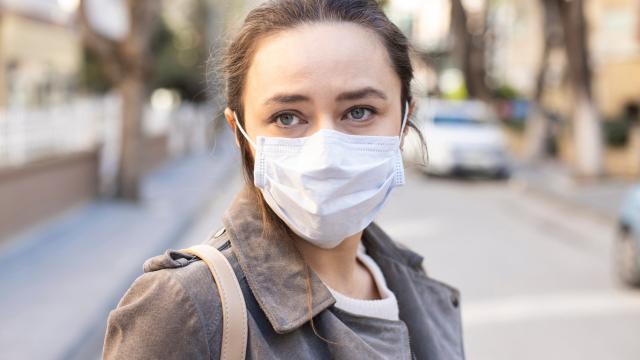As COVID-19 cases spike across the globe, inundating hospital systems and prompting new restrictions on economic activity in some states, it’s important to keep a key distinction in mind, at least when it comes to your own place in the tangled pandemic mess: the difference between infection and exposure.
It should be a little jarring to find out that a loved one or friend tested positive within a few days of your last interaction with them. After all, it’s possible to test positive and come down with symptoms even if you’ve methodically washed your hands, socially distanced yourself, and worn a mask for months on end. Given our evolving knowledge of the virus, how it spreads, and the efficacy of various prophylactics and treatments, it’s understandable that you might not be sure what to do if you’ve potentially faced exposure.
Here’s some key guidelines advocated by medical authorities, so you can act appropriately if you’ve been exposed to potential transmission.
The difference between infection and exposure
The good news: not all exposures lead to infections. It’s possible to cross paths with someone who’s tested positive — or who carries the virus but who hasn’t yet tested positive — and not contract it.
The definition of “exposure” relates to your physical proximity to someone within a certain period of time. Most medical authorities note that spending fifteen minutes, masked or unmasked, within six feet of someone who’s tested positive, displays symptoms, or who tests positive within 48 hours qualifies as exposure.
If, for some reason, it hasn’t been hammered home throughout the last nine months of this unceasing plague, an infection is indicated by a positive COVID test result, or exhibiting the trademark symptoms. Though it’s a go-to method for clamping down on viral spread, the issue of testing isn’t without its hiccups. A person with COVID can still test negative, because the virus has to build up its presence over time to be detected via nasal swab or saliva sample.
As Harvard Medical School states:
If you are tested on the day you were infected, your test result is almost guaranteed to come back negative, because there are not yet enough viral particles in your nose or saliva to detect. The chance of getting a false negative test result decreases if you are tested a few days after you were infected, or a few days after you develop symptoms.
This makes the prospect of exposure thornier, since you could potentially be exposed to the virus by someone who doesn’t know they have it. However, there’s some key guidance that medical authorities recommend if you think you’ve been exposed.
What to do if you’ve been exposed
It can and should be alarming if you fall into this camp, but there’s proactive measures to take to better ensure the safety of those around you.
As the CDC and other global health bodies advise, if you’ve been around someone who starts displaying symptoms two days after you’ve last seen them, the protocol is to stay at home for 14 days after your last contact with the symptomatic person.
Or as the agency puts in its own language:
Stay home until 14 days after last exposure and maintain social distance (at least 1.5 metres) from others at all times
If you’ve been in contact with someone who tests positive within two days of your last contact, but is still asymptomatic, health bodies recommend the same standard 14-day quarantine, starting on the day you believe you were exposed.
You might be wondering about the 48-hour rule and whether it’s an arbitrary number. It definitely isn’t. As the CDC notes, the total incubation period of COVID is around 14 days, but most cases start displaying symptoms and or testing positive within four to five days of exposure.
MIT Medical explains that while it’s possible for someone with COVID to be contagious two days after exposure, the probability rises significantly after 48 hours.
If we figure that infected people who become sick typically start experiencing symptoms a bit more than five days after exposure, we can calculate that infectiousness would, on average, begin rising sharply about three days post exposure. In other words, it’s safe to say that it would be exceedingly rare for anyone to transmit the virus earlier than two days post exposure; however, at some point after that, the risk would begin to rise significantly.
Another obvious thing to do if you feel like you’ve potentially been exposed: get tested. Though testing occasionally yields false results, it’s an undeniable tool in stanching the spread of the virus. Given that the virus typically needs to build up in your system to be detected, it’s a wise choice to get tested a few days after your expected exposure. If you’re displaying no symptoms, maybe wait five days — more than ample time for the virus to usually bear results via testing — to get your test. If you’re already exhibiting symptoms but can manage your own recovery without immediate medical assistance, stay home for 14 days from your point of last suspected exposure.
If you live with or recently spent time with someone who believes they were exposed to COVID, you don’t need to quarantine, according to the CDC, but you do need to monitor yourself for symptoms. If you or the person who was exposed develops symptoms, then you must quarantine.
COVID transmission and contraction obviously hinge on the particulars of your own circumstances, but some of the general rules of epidemiology can help you and your loved ones if you feel you’ve been exposed: stay home for 14 days, limit your contact with others to a threshold of 1.5 metres, and get tested.
This, too, shall pass eventually.

Leave a Reply
You must be logged in to post a comment.